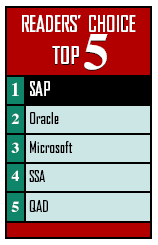Enterprise Resources Planning

And although it's been overshadowed by the Oracle's pursuit of Siebel, there is a joint operation that's simmering just below most radars -- Project Mendocino, the teaming of SAP and Microsoft, the No. 3 Reader's Choice player, that is promising to give users SAP functionality within MS Office. According to AMR Chief Research Officer Bruce Richardson, one SAP executive estimated that his company had about 12 million total R/3 or mySAP users. Microsoft has far higher penetration. "It's not too much of a stretch to imagine SAP adding a lot more seats via Project Mendocino. And, it could do so with relatively low sales costs," predicted Richardson in his November 10 Alert Highlight, "Office 12 v. ERP; In Battle for Business Process Dominance". But don't look to their cooperation the end to some healthy competition. "The real battle may be over the composite applications that can be layered on top of Office and/or mySAP," says Richardson.
Breakout Winners
| 1. Microsoft |
| 2. SAP |
| 3. Oracle |
Customer Experience
Retail giant Target recently adopted Microsoft .NET Framework-based technologies within its 1,400 stores in 47 U.S. states. "Microsoft technologies can help us drive down costs through a simplified architecture and easier-to-use development tools," says Janet Schalk, CIO at Target. "These cost savings will enable us to invest in additional innovations that will enhance the store experience for our guests."
| 1. SAP |
| 2. Microsoft |
| 3. Oracle |
Small/midsize business
Mid-size businesses may lack Tier 1 resources, especially when it comes to investing in top-of-the-line ERP packages. "In considering our ERP solutions we were looking for a big, solid player who had a viable financial component and one that was capable of catering to a smaller company such as ours," says Autumn Bayles, CIO, Tasty Baking Company. "With SAP, we've got the integration we wanted and the capabilities we need for the high velocity business of baking.
The Shrinking ERP Market
As it was in 2004, the story of Enterprise Resource Planning (ERP) in 2005 is one of consolidation. Mergers and acquisitions were center stage, and Oracle was the featured performer. And in the best melodramatic tradition, the year ended with a cliff-hanger worthy of a 1940s movie serial, when, on November 15, Siebel Systems announced that the U.S. Department of Justice cleared its proposed acquisition by Oracle under the Hart-Scott-Rodino Act. Oracle's pursuit of Siebel was, without question, the biggest ERP story of the year, and it could well be the biggest ERP story of 2006 as well. But before we look to the future, it is important to understand how things came to be.
The 900-pound gorilla, of course, is the Oracle-Siebel merger, although the full impact of that won't be known for some time. But we can look back at Oracle's engulfing of PeopleSoft and see that while there seems to be long-term benefits, in the short term, there were the bumps and bruises commonly associated with mergers for both companies, as well as for their clients. "It takes about two years for a company to show even growth (after such an event)," says Chad Eschinger, principal research analyst for Gartner. "And something of that magnitude really brings an impact. Just like it will when Oracle and Siebel finally get together."
But while the big guns are getting bigger, many analysts see a burgeoning wave of benefits for SMBs. In the Forrester Research Market Overview, ERP Applications - The Technology and Industry Battle Heats Up, Paul Hamerman and R "Ray" Wang point out: "The midmarket remains a fertile area for growth, as well as a key competitive battleground, with industry specialization representing the best opportunity for differentiation."
According to Gartner's Eschinger, this midmarket is exactly what Microsoft is after. "That space doesn't really have a leader," Eschinger says. "If Microsoft gets it right, they become a real threat." But that will require some relatively quick movement from Microsoft. As the big get bigger though mergers, their ability to steal market share from one another amongst Tier One CPG companies is diluted. As a result, look for the major players to get more aggressive in efforts to serve SMBs. Mergers, though, will likely remain the biggest story in ERP in 2006. And none will be more closely watched than Oracle and Siebel. "It's all going to come down to how Oracle deals with Siebel's clients," says Kara Romanow, research director at AMR Research. "If they do it well, they'll be okay. If not..." We'll all be watching.
